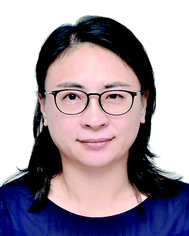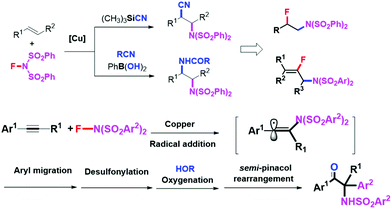DOI: 10.1039/D0QO90004D
(Profile)
Org. Chem. Front., 2020, 7, 735-736
Interview with Qian Zhang
Department of Chemistry, Northeast Normal University, China. E-mail: Zhangq651@nenu.edu.cn; Web: http://zhanggroup.pro
Received
10th January 2020
, Accepted 10th January 2020
What inspired you to choose science and eventually become a chemist in the first place?
As a teacher at university, at first, I just wanted to pass on chemistry knowledge to students more flexibly and deeply through scientific research. During this course, I became fascinated and eventually became a chemist.How do you define ‘a successful scientist’ and how can success be achieved?
A successful scientist is motivated by their enjoyment of research, is recognised within the field, makes contributions to science, and of course makes a good living through their own professional efforts. Success should be based on the concept of pursuing truth, brave exploration, diligent innovation and being honest, as well as being lucky to meet great inspirational mentors.Do you have any tips for doing successful scientific research?
Constant passion, indestructible will, and infinite inspiration.What are your hobbies? Is there a relationship between your hobbies and research?
I like skiing, swimming, running, listening to music, and reading. Taking the relationship between my skiing hobby and my research as an example, I experience nature by integrating into the snowy mountain, calmly respond to all possible dangers, and think deeply about every action that needs to be improved to achieve a perfect glide. All of these feelings relate to the beauty of exploring the world through scientific research, and involve the same goal in different ways.How is a work–life balance achieved?
Scientific research does not need to be focused on every aspect, but should be aimed at the most important point. Life is wonderful, but don't get too involved in the details. Therefore, decisive choice is the key to balance.What are your suggestions for the younger generation to encourage them to consider a career in science?
It's a really challenging profession, in which you constantly learn, generate ideas, and make people feel infinite passion and vitality.If you were not a chemist, which career would you choose?
Detective. When I was young, I liked detective novels and TV plays. I was fascinated by the stories that were successfully solved through observation and analysis of details. It was once my dream to be a detective, but I didn't know that it is also related to my current occupation. Solving key scientific problems in the field also involves careful analysis and consideration of details.References
- H. Li, M. Zhang, H. Mehfooz, D. Zhu, J. Zhao and Q. Zhang, Highly convergent modular access to poly-carbon substituted cyclopropanes via Cu(I)-catalyzed three-component cyclopropene carboallylation, Org. Chem. Front., 2019, 6, 3387–3391 RSC.
- Z. Y. Li, J. B. Zhao, B. Z. Sun, T. T. Zhou, M. Z. Liu, S. Liu, M. R. Zhang and Q. Zhang, Asymmetric Nitrone Synthesis via Ligand-Enabled Copper-Catalyzed Cope-Type Hydroamination of Cyclopropene with Oxime, J. Am. Chem. Soc., 2017, 139, 11702–11705 CrossRef CAS PubMed.
- T. W. Pouambeka, G. Zhang, G. Zheng, G. Xu, Q. Zhang, T. Xiong and Q. Zhang, Copper-catalyzed oxidative amidation of α,β-unsaturated ketones via selective C–H or C–C bond cleavage, Org. Chem. Front., 2017, 4, 1420–1424 RSC.
- G. Zhang, T. Xiong, Z. Wang, G. Xu, X. Wang and Q. Zhang, Highly Regioselective Radical Amination of Allenes: Direct Synthesis of Allenamides and Tetrasubstituted Alkenes, Angew. Chem., Int. Ed., 2015, 54, 12649–12653 CrossRef CAS PubMed.
- G. Zheng, Y. Li, J. Han, T. Xiong and Q. Zhang, Radical Cascade Reaction of Alkynes with N-Fluoroarylsulfonimides and Alcohols, Nat. Commun., 2015, 6, 7011 CrossRef CAS PubMed.
- H. Zhang, Y. Song, J. Zhao, J. Zhang and Q. Zhang, Regioselective Radical Aminofluorination of Styrenes, Angew. Chem., Int. Ed., 2014, 53, 11079–11083 CrossRef CAS PubMed.
- H. Zhang, W. Pu, T. Xiong, Y. Li, X. Zhou, K. Sun, Q. Liu and Q. Zhang, Copper-Catalyzed Intermolecular Aminocyanation and Diamination of Alkenes, Angew. Chem., Int. Ed., 2013, 52, 2529–2533 CrossRef CAS PubMed.
- Z. Ni, Q. Zhang, T. Xiong, Y. Zheng, Y. Li, H. Zhang, J. Zhang and Q. Liu, Highly Regioselective Copper-Catalyzed Benzylic C–H Amination by N-Fluorobenzenesulfonimide, Angew. Chem., Int. Ed., 2012, 51, 1244–1247 CrossRef CAS PubMed.
- T. Xiong, Y. Li, X. Bi, Y. Lv and Q. Zhang, Copper-Catalyzed Dehydrogenative Cross-Coupling Reactions of N-p-Tolylamides through Successive C–H Activation: Synthesis of 4H-3,1-Benzoxazines, Angew. Chem., Int. Ed., 2011, 50, 7140–7143 CrossRef CAS PubMed.
- K. Sun, Y. Li, T. Xiong, J. Zhang and Q. Zhang, Palladium-Catalyzed C–H Aminations of Anilides with N-Fluorobenzenesulfonimide, J. Am. Chem. Soc., 2011, 133, 1694–1697 CrossRef CAS PubMed.
| This journal is © the Partner Organisations 2020 |


